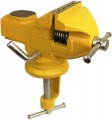Clamping width provided by vise or clamp (see "Type")
In this case, the width of the clamp means the maximum distance that the jaws or stops of the tool can be spread, in other words, the maximum size of an object that can be clamped with this device.
Large clamping width, on the one hand, makes the tool more versatile and expands its capabilities; on the other hand, it affects the dimensions, weight and price, and also makes it difficult to work with small objects (a large tool is poorly suited for this). So, when choosing according to this parameter, you should not chase after the maximum margin, but take into account the size of the parts that you really plan to work with: for example, it hardly makes sense to buy a 500 mm clamp if you need a clamp for gluing plywood planks together.
The main material used in the construction of the tool.
—
Steel. In most cases, we are talking about classic tool steel — high-carbon or alloyed; both varieties have increased hardness and abrasion resistance. At a relatively low cost, this material is reliable, durable, practical and suitable for even the most powerful tools operating under high loads. But the resistance to corrosion of tool steel can be different: in particular, its carbon varieties do not tolerate contact with moisture, it is advisable to protect products from such materials from moisture and lubricate for storage. Anyway, detailed recommendations for the maintenance of the tool can be found in the instructions for it.
—
Cast iron. Cast iron is the "closest relative" of steel and differs from it primarily in its higher carbon content. This material is somewhat cheaper, but more fragile and less reliable, which is why it is poorly suited for high loads and is less resistant to shock.
—
Aluminium. The main advantage of aluminium alloys can be called a small weight; in addition, they are excellently resistant to corrosion. At the same time, such materials are poorly suited for high loads, and therefore are mainly used in relatively compact tools that are not designed for high working forces.
—
Plastic. Plastic is inexpensive and weighs a litt
...le, but it is noticeably inferior in strength even to aluminium and cast iron, not to mention steel. Therefore, it is used not so much as the main body material, but as a material for stops and linings; many "plastic" models are actually steel or aluminium tools, complete with plastic parts. The meaning of this design is that the plastic stops are very gentle on the compressible parts, making them suitable even for delicate materials; and thanks to the metal base, the clamping force in such tools can be quite high.
— Tree. The tree has a relatively low strength, therefore it is used only in certain models of clamps, and only sponges or stops are made from it — the rest of the structure is made of metal. Such tools cannot provide high clamping force, but this is not required, wooden clamps have a different specialization: they are designed for relatively soft and delicate materials that can be damaged by hard metal jaws or excessive clamping force.
— Magnesium. Magnesium alloys combine light weight, high strength and excellent corrosion resistance. On the other hand, their price is also quite high, which is why such materials are rare — mainly in clamps (see "Type"), which use relatively little metal.
— Zinc. Zinc alloys are quite durable and resist corrosion well. However, in terms of reliability and working properties, they are generally inferior to steel, and therefore are relatively rare.
